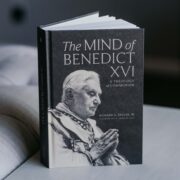They had a beautiful wedding in Paris, but the trouble in the marriage began almost at once. Despite his premarital promise to respect her Catholic beliefs, Dr. Felix Leseur began to undertake to destroy the faith of his wife Elisabeth. He tried to argue her out of her faith and left atheist pamphlets around the house.
However, his efforts had a surprising effect. His attacks raised questions, and she sought answers. Rather than giving up her faith, she began to read the Gospel accounts of the life of Jesus slowly and thoughtfully. She read about the saints. She learned the intellectual foundations of her faith. She began to serve the poor and needy in her community. She began to pray continually for the soul of her husband and the souls of all with whom she had contact.
But her husband did not let up on his hopes of destroying her faith. Though he remained a loving husband in other ways, he redoubled his efforts to show the foolishness of Catholicism, putting tremendous strain on their relationship. He even wrote books and edited a newspaper aimed at promoting atheism and showing the foolishness of Catholicism. He filled the family bookshelves with anti-religious tracts and invited his secular friends to their house to show her the error of her ways.
Suffering is the highest form of action, the highest expression of the wonderful Communion of Saints . . .
In response, she sought to really understand him. She aimed “to go more and more to souls, approaching them with respect and delicacy, touching them with love. Try always to understand everything and everyone. Not to argue; to work instead through contact and example; to dissipate prejudice, to reveal God and make him felt without speaking of him; to strengthen one’s intelligence, to enlarge one’s soul . . . to love without tiring, in spite of disappointment and indifference . . . to disclose Truth in its entirety and yet make it known according to the degree of light that each soul can bear.” She wrote, “I want to love, with a special love, those whose birth or religion or ideas separate them from me; it is those whom I must try to understand and who need me to give them a little of what God has placed within me.” She met her husband not with ridicule and rebuke but with love and understanding. She prayed even more for him.
But then she was struck by a terrible illness—breast cancer. The treatments were ineffectual. She became so sick that she couldn’t even continue her work in helping the poor. She was confined to her bed in agony.
Yet this loss of physical powers did not deter her from care and love for others. She wrote, “I know by experience that in hours of trial certain graces are obtained for others, which all our efforts had not hitherto obtained. I have thus come to the conclusion that suffering is the highest form of action, the highest expression of the wonderful Communion of Saints, and that in suffering one is sure not to make mistakes (as in action, sometimes)—sure, too, to be useful to others and to the great causes that one longs to serve.” She offered up her suffering like St. Paul who wrote, “I complete what is lacking in Christ’s afflictions for the sake of His body, that is, the Church” (Col. 1:24). As George MacDonald noted, the Son of God suffered unto death, not that we might not suffer, but that our suffering might be like his.

Felix did notice how courageously his wife bore her suffering. He saw that her faith made her strong, made her loving, made her beautiful.
As she was about to die at the age of forty-seven, she said to her husband, “Felix, when I am dead, you will become a Catholic and a Dominican priest.” He replied, “Elisabeth, you know my sentiments. I’ve sworn hatred of God, I shall live in the hatred, and I shall die in it.” She repeated her words and then died in his arms.
Elisabeth’s funeral was enormous, filled with many people Felix had never seen whom Elisabeth had helped. After her death, Felix began to read Elisabeth’s papers, journals, and correspondence. But he dismissed these writings, like her dying words, as pious ramblings. Indeed, his own atheistic convictions were stronger than ever. So, he traveled to the Sanctuary of Our Lady of Lourdes in order to do research for a book disproving the allegedly miraculous events there, including many miracles of healing.
But when he arrived at Lourdes, he looked, as if for the first time, at the face of the statue of Our Lady of Lourdes. When he looked at Mary’s face, Felix received the gift of faith—totally, completely, and deeply. He wrote, “A revolution took place in my whole moral being. I understood the celestial beauty of Elisabeth’s soul and that she had accepted all her suffering and offered it—and even offered her very self in sacrifice—chiefly for my conversion. . . . Her sacrifice was absolute, and she was convinced that God would accept it and would take her early to Himself. She was equally persuaded that He would ensure my conversion.”
Many years after Elisabeth Leseur died, Bishop Fulton J. Sheen heard all about her heroic life during a retreat. The retreat was undertaken under the direction of a Catholic, a priest, and a Dominican. The Dominican priest’s name was Felix Leseur.
Fr. Leseur spent the rest of his life telling others about the heroic love and sacrifice of his wife Elisabeth.
